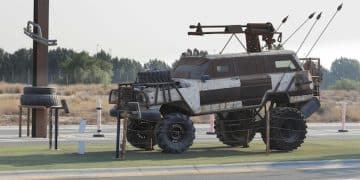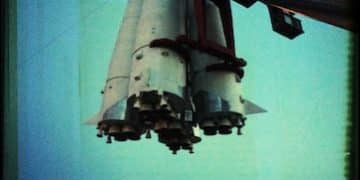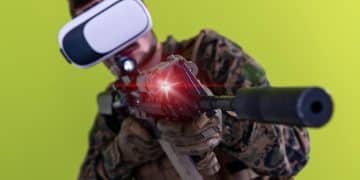The Future of Drone Swarms: US Military Investments & Tech Advances
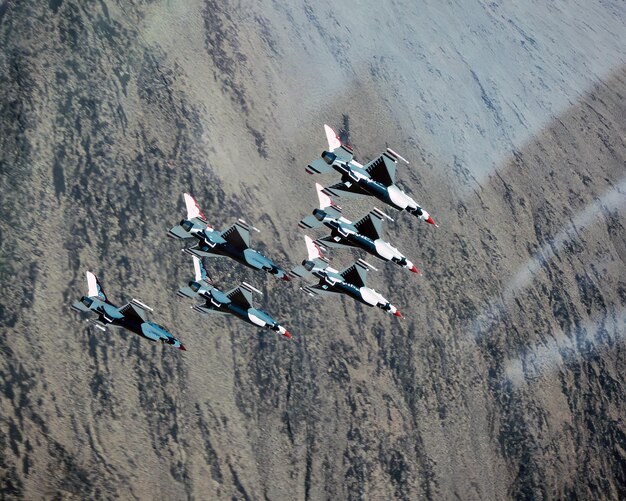
The future of drone swarm technology is being heavily shaped by the US Military’s investments, driving advancements in coordinated autonomous systems for surveillance, reconnaissance, and potentially combat applications.
The rise of drone technology has transformed numerous sectors, and the military domain is no exception. Among the most intriguing developments is the concept of drone swarms, where multiple unmanned aerial vehicles (UAVs) operate in a coordinated manner to achieve a common objective. The US Military is significantly investing in the future of drone swarm technology: analyzing the US Military’s latest investments, indicating its potential to revolutionize modern warfare and defense strategies.
Understanding Drone Swarm Technology
Drone swarm technology represents a paradigm shift in how unmanned aerial vehicles are utilized. Instead of operating independently, drones in a swarm work together, sharing information and coordinating their actions to accomplish complex tasks. This collective approach offers numerous advantages over traditional, single-drone deployments.
Benefits of Drone Swarms
Drone swarms offer several key benefits. First, they provide enhanced redundancy. If one drone fails, the swarm can adapt and continue functioning. Second, they increase efficiency by distributing tasks across multiple units. Third, they improve situational awareness by collecting and sharing data from various perspectives.
- Enhanced Redundancy: Swarms maintain operational integrity even with individual drone failures.
- Increased Efficiency: Tasks are distributed, leading to faster completion times.
- Improved Situational Awareness: Comprehensive data collection from multiple vantage points.
- Scalability: Swarms can be scaled up or down as needed, offering flexibility in deployment.
These advantages make drone swarm technology particularly appealing to the military, where adaptability and resilience are paramount.

In summary, drone swarm technology is a disruptive innovation that enhances operational capabilities through coordinated autonomy. Its potential military applications are vast, and the US Military is at the forefront of this technological evolution.
US Military’s Investments in Drone Swarms
The US Military has been actively investing in drone swarm technology research and development. These investments span various branches of the military, including the Army, Navy, and Air Force, each exploring unique applications tailored to their specific needs.
DARPA’s Role in Drone Swarm Development
The Defense Advanced Research Projects Agency (DARPA) plays a crucial role in advancing drone swarm technology. DARPA’s OFFSET (Offensive Swarm-Enabled Tactics) program, for example, aims to develop swarm technologies that can be used in urban environments.
These investments are geared towards creating drone swarms capable of navigating complex terrains, identifying threats, and coordinating attacks. The ultimate goal is to provide warfighters with a decisive advantage on the battlefield.
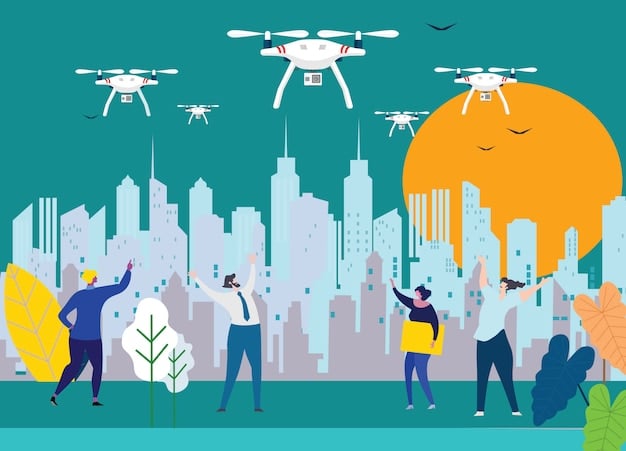
- OFFSET Program: Focuses on developing swarm tactics for urban operations.
- Low-Cost UAV Swarm Technology (LOCUST): Navy program for launching large numbers of UAVs.
- Perdix Micro-Drone Program: Air Force initiative for creating resilient and adaptive drone swarms.
The US Military’s commitment to drone swarm technology is evident in the substantial funding allocated to these projects. These investments are not only driving technological advancements but also shaping the future of military strategy.
In conclusion, the US Military’s investments in drone swarm technology are multifaceted, covering a wide range of applications and technological advancements. These efforts underscore the strategic importance of drone swarms in future military operations.
Potential Military Applications of Drone Swarms
Drone swarms present a wealth of potential military applications, ranging from reconnaissance and surveillance to electronic warfare and coordinated attacks. Their ability to operate autonomously and in a coordinated manner makes them invaluable assets in modern warfare.
Reconnaissance and Surveillance
Drone swarms can be deployed to gather intelligence in high-risk environments. They can provide real-time video feeds, identify enemy positions, and monitor critical infrastructure. The sheer number of drones in a swarm makes it difficult for adversaries to detect and counter their surveillance efforts.
Moreover, drone swarms can be equipped with various sensors, including thermal imaging cameras and radar systems, to enhance their reconnaissance capabilities. This allows them to operate effectively in diverse weather conditions and environments.
- Real-Time Intelligence: Providing immediate situational awareness to commanders.
- High-Risk Environment Monitoring: Gathering data in hazardous areas without risking human lives.
- Infrastructure Protection: Monitoring critical assets to prevent attacks or sabotage.
- Target Identification: Locating and identifying enemy targets for subsequent engagement.
In essence, drone swarms enhance military effectiveness by providing timely and accurate intelligence, which is crucial for informed decision-making.
In conclusion, the potential military applications of drone swarms are vast and transformative. Their ability to enhance reconnaissance, conduct electronic warfare, and execute coordinated attacks makes them a critical component of future military strategies.
Technological Challenges and Solutions
Despite the immense potential of drone swarm technology, several technological challenges must be addressed to ensure its effective deployment. These challenges include communication, autonomy, and cybersecurity.
Communication Challenges
Maintaining reliable communication between drones in a swarm is essential for coordinated operation. However, communication networks can be disrupted by signal jamming, interference, or physical obstacles. To overcome these challenges, researchers are exploring various solutions, such as using resilient communication protocols and decentralized control architectures.
These solutions ensure that the swarm can continue functioning even if some communication links are compromised. Additionally, advanced encryption techniques are being developed to protect communication channels from eavesdropping and tampering.
- Resilient Communication Protocols: Ensuring reliable communication in contested environments.
- Decentralized Control Architectures: Allowing drones to operate independently if communication is lost.
- Advanced Encryption Techniques: Protecting communication channels from cyber threats.
By addressing these communication challenges, the reliability and effectiveness of drone swarms can be significantly enhanced.
In summary, overcoming these technological challenges is critical for realizing the full potential of drone swarm technology. Ongoing research and development efforts are focused on creating robust and secure drone swarms that can operate effectively in complex military environments.
Ethical Considerations and Policy Implications
The development and deployment of drone swarm technology raise significant ethical considerations and policy implications. These include concerns about autonomous decision-making, the potential for unintended consequences, and the impact on international law.
Autonomous Decision-Making
One of the primary ethical concerns is the extent to which drone swarms should be allowed to make decisions autonomously. If drones are given the authority to select and engage targets without human intervention, there is a risk of unintended harm to civilians or misidentification of legitimate targets.
To mitigate these risks, it is essential to establish clear ethical guidelines and regulatory frameworks for the use of autonomous weapons systems. These frameworks should ensure that human operators retain meaningful control over critical decisions, even in fast-paced combat scenarios.
- Clear Ethical Guidelines: Establishing moral boundaries for the use of autonomous weapons.
- Regulatory Frameworks: Creating legal standards for the deployment of drone swarms.
- Human Oversight: Ensuring human operators retain control over critical decisions.
By addressing these ethical considerations, the potential for unintended consequences can be minimized, and the responsible use of drone swarm technology can be promoted.
In conclusion, addressing these ethical considerations and policy implications is crucial for ensuring that drone swarm technology is developed and deployed in a responsible and ethical manner. International cooperation and dialogue are essential for establishing global norms and standards for the use of autonomous weapons systems.
Future Trends in Drone Swarm Technology
The future of drone swarm technology is marked by several key trends, including advancements in artificial intelligence, increased autonomy, and the integration of diverse sensor technologies. These trends are expected to further enhance the capabilities and applications of drone swarms in the military domain.
Advancements in Artificial Intelligence
Artificial intelligence (AI) is playing an increasingly important role in drone swarm technology. AI algorithms enable drones to analyze vast amounts of data in real-time, make autonomous decisions, and adapt to changing environments. This enhances their ability to perform complex tasks without human intervention.
Moreover, AI is being used to improve the coordination and communication between drones in a swarm. AI-powered algorithms can optimize flight paths, distribute tasks, and detect anomalies, leading to more efficient and effective swarm operations.
- Real-Time Data Analysis: AI algorithms enable drones to process and interpret data instantaneously.
- Autonomous Decision-Making: Drones can make decisions without human input, improving response times.
- Improved Coordination: AI optimizes communication and task distribution within the swarm.
In summary, the integration of AI is transforming drone swarm technology, enabling new levels of autonomy and operational effectiveness.
In conclusion, the future of drone swarm technology is bright, with ongoing advancements in AI, autonomy, and sensor technologies promising to revolutionize military operations. The US Military is poised to remain at the forefront of this technological evolution, shaping the future of warfare and defense strategies.
| Key Point | Brief Description |
|---|---|
| 🚀 Drone Swarm Tech | Multiple drones work together, sharing data. |
| 💰 US Military Investment | Significant funding across branches for R&D. |
| 🎯 Military Applications | Recon, surveillance, electronic warfare, attacks. |
| 🤖 AI & Autonomy | AI enhances real-time data analysis and decision-making. |
Frequently Asked Questions
What are drone swarms?
What are drone swarms?
▼
Drone swarms are groups of unmanned aerial vehicles (UAVs) that operate in a coordinated and autonomous manner to achieve a common objective, enhancing efficiency and redundancy.
How is the US Military investing in drone swarms?
How is the US Military investing in drone swarms?
▼
The US Military invests through various branches like the Army, Navy, and Air Force, with programs like DARPA’s OFFSET focusing on urban operations and swarm tactics.
What are the main challenges facing drone swarm technology?
What are the main challenges facing drone swarm technology?
▼
Key challenges include maintaining reliable communication, achieving full autonomy, and ensuring cybersecurity to protect against signal jamming and cyber threats.
What ethical concerns arise from using drone swarms?
What ethical concerns arise from using drone swarms?
▼

